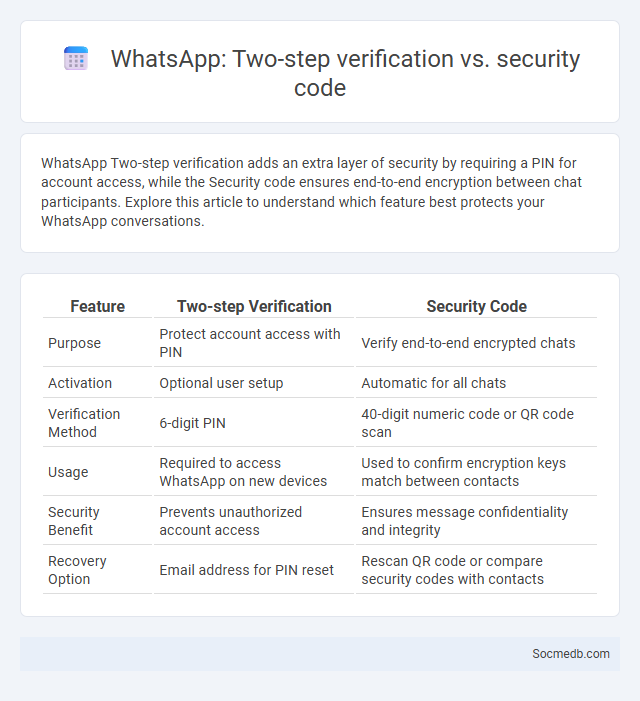
Photo illustration: WhatsApp Two-step verification vs Security code
WhatsApp Two-step verification adds an extra layer of security by requiring a PIN for account access, while the Security code ensures end-to-end encryption between chat participants. Explore this article to understand which feature best protects your WhatsApp conversations.
Table of Comparison
| Feature | Two-step Verification | Security Code |
|---|---|---|
| Purpose | Protect account access with PIN | Verify end-to-end encrypted chats |
| Activation | Optional user setup | Automatic for all chats |
| Verification Method | 6-digit PIN | 40-digit numeric code or QR code scan |
| Usage | Required to access WhatsApp on new devices | Used to confirm encryption keys match between contacts |
| Security Benefit | Prevents unauthorized account access | Ensures message confidentiality and integrity |
| Recovery Option | Email address for PIN reset | Rescan QR code or compare security codes with contacts |
Introduction to WhatsApp Security Features
WhatsApp integrates advanced security features such as end-to-end encryption, ensuring that your messages, calls, and shared media remain private and accessible only to you and your intended recipients. Security measures include two-step verification, which adds an extra layer of protection against unauthorized access, and biometric lock options to prevent others from opening your app. These features collectively safeguard your personal information and enhance your overall social media security experience.
What is Two-Step Verification in WhatsApp?
Two-Step Verification in WhatsApp is an important security feature that adds an extra layer of protection to your account by requiring a six-digit PIN in addition to your phone number during the login process. This verification helps prevent unauthorized access even if your SIM card or phone number is compromised. Enabling Two-Step Verification ensures your personal messages and social media interactions remain secure from potential hackers.
Understanding WhatsApp’s Security Code
WhatsApp's security code is a unique 60-digit number used to verify end-to-end encryption between users, ensuring that messages remain private and tamper-proof. By comparing security codes through QR codes or numeric sequences, users can confirm that their conversations are secure and not intercepted by third parties. This feature underscores WhatsApp's commitment to preserving user privacy and protecting data from unauthorized access on social media platforms.
Differences Between Two-Step Verification and Security Code
Two-step verification requires users to provide two forms of identification, often a password and a one-time code sent via SMS or an authenticator app, enhancing account security against unauthorized access. Security codes, typically sent as SMS or generated by an app, serve as a single-use password during login or transaction approval but do not constitute a complete authentication process on their own. The primary difference lies in two-step verification involving multiple authentication factors, whereas security codes function as one-time credentials within or separate from a two-step process.
How to Enable WhatsApp Two-Step Verification
To enable WhatsApp two-step verification, open the app and go to Settings > Account > Two-step verification. Tap on Enable, then create a six-digit PIN, which adds an extra layer of security to your account. You can also provide an email address for PIN recovery, ensuring you can reset it if forgotten.
The Role of Security Codes in WhatsApp Chats
Security codes in WhatsApp chats play a crucial role in ensuring end-to-end encryption, protecting your messages from unauthorized access by verifying the identity of the contacts you communicate with. These codes change whenever you or your contact reinstall WhatsApp or change devices, signaling the need for re-verification to maintain secure communication. Maintaining awareness of these security codes helps you safeguard your private conversations against potential interception or hacking attempts on social media platforms.
Pros and Cons of Two-Step Verification
Two-step verification enhances social media security by adding an extra authentication layer beyond just passwords, significantly reducing risks of unauthorized access and account hacking. However, it can complicate the login process, sometimes causing user frustration, especially if the verification device is unavailable or delayed. While protecting personal information and preventing identity theft, two-step verification may lead to temporary account lockouts if users lose access to their secondary authentication methods.
Common Myths About WhatsApp Security Features
WhatsApp security features are often misunderstood, leading to common myths that can misguide users about their privacy. End-to-end encryption ensures that only you and the person you're communicating with can read the messages, making it impossible for WhatsApp or third parties to access your chats. Believing that disabling read receipts or using backup features compromises encryption is incorrect, as these actions do not weaken the app's fundamental security protections.
Best Practices for Maximum Account Protection
To maximize account protection on social media, enable two-factor authentication (2FA) on all platforms, ensuring an extra layer of security beyond just passwords. Regularly update passwords with complex combinations of letters, numbers, and symbols, and avoid using the same password across multiple accounts. Vigilantly monitor account activity for unauthorized access and promptly revoke permissions for suspicious third-party apps to safeguard personal information.
Conclusion: Choosing the Right WhatsApp Security Setting
Choosing the right WhatsApp security setting involves enabling end-to-end encryption, activating two-step verification, and regularly reviewing privacy controls to protect personal data from unauthorized access. Users should tailor security options based on their communication needs and threat levels, ensuring that message confidentiality and account integrity are maintained. Implementing these optimized security measures significantly reduces the risk of cyber threats and enhances overall WhatsApp account protection.
 socmedb.com
socmedb.com